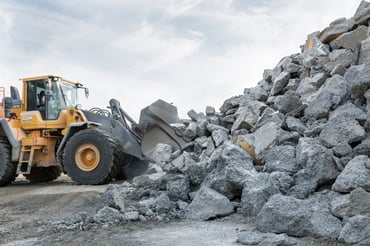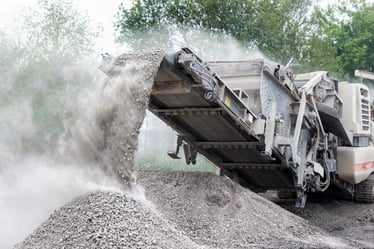Concrete is the most widely used construction material in the world – and also the most environmentally discussed. One reason for this is its reliance on sand as a component – the third most vital natural resource to humans after air and water. Read on to find out why sand extraction is such a critical issue and how innovative technology is helping to provide alternative solutions…
The increasing demand for sand
Sand is included almost everywhere: in glass, in toothpaste, in hairspray, in aircraft engines and, of course, in concrete. The construction industry’s demand for sand is becoming increasingly challenging as the quantity available becomes ever-more scarce. Looking at the big picture, a staggering 60 billion tonnes of natural resources are mined every year (2020 estimate). Sand and gravel are being extracted at record rates, accounting for around 85% per cent of the weight of minerals mined globally (Leal Filho et al., 2021), and the UN estimates that around 40-50 billion tonnes of sand are used every year.
Unsurprisingly, the renewal rate of this natural resource is vastly outstripped by the speed of its extraction, as highlighted by the United Nations Environment Programme (UNEP)’s 2019 report Sand and Sustainability: Finding new solutions for environmental governance of global sand resources. It’s no exaggeration to say that there is a global sand crisis (Leal Filho et al., 2021), to the extent that illegal sand extraction is becoming an added problem and intervention through governmental planning, policy and regulation and management is necessary to get the situation under control.
The Global Sand Observatory describes sand resource governance as ‘one of the greatest sustainability challenges of the 21st century’ Today, it’s widely recognized that the global reliance on removing sand from our ecosystems at this scale is unsustainable and a cause for international concern as reserves become depleted.
Why does sand extraction cause such a problem?
The environmental consequences of sand extraction are far-reaching. The amount of sand currently being mined has a serious impact on rivers, deltas and coastal and marine ecosystems. As reserves decrease faster than new mining areas being approved, it will become harder, more expensive and more challenging to extract sand. Beyond its effect on the environment, sand extraction brings issues at a societal level. Unregulated sand extraction is likely to involve people working outside of acceptable conditions. The current circumstances are bringing sand into the focus of science and leading to new technological developments to make better use of existing resources.
Tackling the problem with alternative materials
 One approach to decreasing the demand for sand as a component of concrete is to increase the use of recycled and alternative materials in construction projects. Serious research into incorporating recycled aggregates produced from construction and demolition waste (CDW) into concrete mixes dates back to the 1970s.
One approach to decreasing the demand for sand as a component of concrete is to increase the use of recycled and alternative materials in construction projects. Serious research into incorporating recycled aggregates produced from construction and demolition waste (CDW) into concrete mixes dates back to the 1970s.
Using recycled materials has the dual benefit of reducing the use of new natural resources and avoiding sending waste material to landfill. However, finding a suitable substitute for sand brings its own problems. Using recycled aggregates, while a sensible and responsible choice, involves overcoming a number of potential challenges:
- The composition and quality of aggregates can vary considerably
- Increased slump loss is possible
- Ensuring the required water/cement values is difficult
- Water demand and porosity of crushed sands are usually significantly higher compared to natural sands
So how can you factor in the possibility that recycled concrete may change mix consistence and bring quality restrictions alongside decreased durability?
The admixture solution: MasterSuna RCA

Master Builders Solutions has developed MasterSuna RCA – a pioneering, patented admixture solution devised to allow the use of up to 100% recycled aggregates without compromising on workability retention, thus meeting technical performance requirements. It uses innovative technology to produce high-quality concrete with challenging materials, allowing for robust recycling.
A mix using MasterSuna RCA can be adjusted to offer better consistency control or lower water content, according to the concrete specification. With an optimized exploitation of raw materials and a 10% decrease in carbon footprint due to local availability of materials, the sustainability benefits are clear. You can read more about MasterSuna RCA’s success story here.
Achieving a lower environmental impact has to be a major concern for responsible designers, engineers and structure owners. Using a suitable admixture solution, recycled waste materials such as brick mixes, crushed concrete or ceramics become suitable without the additional use of sand or gravel. Here, admixture technology can offer a win-win solution to the problem in many situations as responsible mineral resource governance becomes an increasingly hot topic.
If you have any inquiries or need further information, please don't hesitate to contact our MasterSuna expert, Raphael. Additionally, you can explore his article here to gain more insights on how the construction industry can contribute to a circular economy.
References:
Leal Filho, W., Hunt, J., Lingos, A., Platje, J., Vieira, L., Will, M., & Gavriletea, M. (2021). The Unsustainable Use of Sand: Reporting on a Global Problem. Sustainability, 13(6), 3356. MDPI AG. Retrieved from http://dx.doi.org/10.3390/su13063356
The Global Sand Observatory. (n.d.). Retrieved June 29, 2021, from https://www.greengrowthknowledge.org/initiatives/global-sand-observatory
UNEP. (2019). Sand and Sustainability: Finding new solutions for environmental governance of global sand resources. GRID Geneva, United Nations Environment Programme, Geneva, Switzerland.


